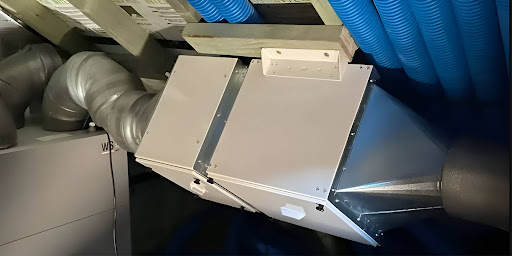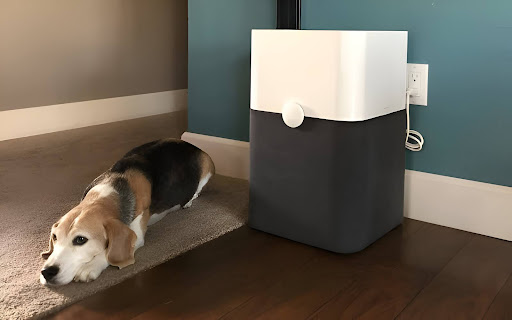
A COMPREHENSIVE GUIDE ON HOW TO PROPERLY INSTALL A SUB FLOOR VENTILATION SYSTEM IN YOUR HOME
Subfloor ventilation is crucial for maintaining a healthy home environment. By ensuring proper airflow beneath the floor, subfloor ventilation helps prevent issues like mould growth, wood rot, and pest infestations. Without adequate ventilation, moisture can accumulate in the subfloor, leading to a range of problems that can affect both the structural integrity of the building and the health of its occupants. Investing in subfloor ventilation is a proactive step towards creating a dry, well-ventilated space that promotes better indoor air quality and overall well-being for you and your family.
WHY YOU NEED SUB FLOOR VENTILATION.
Poor subfloor ventilation can lead to a host of problems that can impact both your home and your health. One major issue is moisture build-up, which can create a damp environment conducive to mould growth. Mould not only damages surfaces but also poses health risks, especially for those with respiratory issues or allergies. Additionally, inadequate ventilation can result in structural damage to floor joists and beams, compromising the stability of your home over time.
Subfloor ventilation systems are designed to address these issues by promoting airflow beneath the floor. These systems work by introducing fresh air into the subfloor space and expelling stale air, effectively reducing moisture levels.
By improving ventilation, subfloor systems help prevent mould growth, protect floor structures from rot, and create a drier environment that is less attractive to pests like termites and rodents. Furthermore, proper subfloor ventilation contributes to better indoor air quality by reducing the presence of mould spores and musty odours, creating a healthier living environment for occupants.
Investing in subfloor ventilation is essential for maintaining a dry, healthy home. With a proper subfloor ventilation system, you can solve moisture build-up and its associated problems, such as mould growth and structural damage, and preserve the integrity of your home and ensure the well-being of its inhabitants.
THE EFFECTS OF A NEGATIVE PRESSURE SUBFLOOR SYSTEM
Negative pressure systems work by using exhaust fans to draw out moist air from the subfloor space, creating a pressure difference that encourages airflow. These systems rely on the principle of air movement from areas of higher pressure to lower pressure, effectively expelling damp air to the outside. By removing moist air, negative pressure systems aim to reduce humidity levels in the subfloor, preventing issues like mould growth and structural damage.
However, negative pressure systems have limitations that homeowners should be aware of. One drawback is that these systems often rely on passive inlets for fresh air intake, which may not always provide a consistent or sufficient airflow. This reliance on passive ventilation can lead to inefficiencies in air exchange, potentially allowing moisture to linger in the subfloor. Additionally, negative pressure systems may create suction issues, pulling in dust, debris, and other contaminants from the crawl space into the living areas of the home. This can compromise indoor air quality and create additional maintenance challenges for homeowners.
YOU NEED A BALANCED SUBFLOOR SYSTEM FOR YOUR HOME

Balanced pressure systems operate by combining exhaust fans with inlet vents to create a controlled airflow in the subfloor space. These systems work by expelling moist air through exhaust fans while simultaneously drawing in fresh air through inlet vents, maintaining a balance between air intake and exhaust.
The benefits of balanced pressure systems lie in their efficiency and ability to provide controlled air circulation throughout the subfloor area. By actively managing both air intake and exhaust, these systems ensure a consistent flow of fresh air while expelling damp air, creating a healthier environment under the floor.
Unlike negative pressure systems, balanced pressure systems help to mitigate the risk of negative pressure effects, such as suction issues or the introduction of contaminants from the crawl space into the living areas of the home. This balanced approach to ventilation promotes better indoor air quality and reduces the likelihood of moisture-related problems.
DIY VS. PROFESSIONAL SUBFLOOR VENTILATION INSTALLATION
When considering installing a subfloor ventilation system yourself, it’s important to understand the differences between basic and complex systems. Basic systems typically involve simple setups with minimal components, making them more straightforward for you to DIY install.
On the other hand, complex systems may require additional expertise and tools due to their advanced features and configurations. Assessing the complexity of the system you plan to install can help determine if it’s a suitable DIY project.
While DIY installation of a subfloor ventilation system is possible, there are challenges to consider. One common challenge is selecting the right size and type of fan for your specific subfloor area. Choosing an inadequate fan size or type can impact the system’s effectiveness in controlling moisture levels.
Additionally, proper placement of vents is crucial for ensuring optimal airflow throughout the subfloor space. Incorrect vent placement can lead to uneven ventilation and potential issues with moisture control. Another challenge to be mindful of is ensuring electrical safety during the installation process. Working with electrical components requires caution and adherence to safety guidelines to prevent hazards.
WHY CHOOSE VENTIS FOR PROFESSIONAL INSTALLATION?
When it comes to installing a subfloor ventilation system, it’s crucial to rely on professionals who have the expertise and experience to do the job right. At Ventis, we excel in designing balanced sub-floor systems that effectively control moisture and promote optimal airflow in your home. Our team understands the importance of proper system sizing and airflow calculations to ensure that your subfloor ventilation system operates efficiently and effectively, tailored to your specific needs.

At Ventis, we prioritise the use of high-quality, durable materials in our installations to guarantee longevity and performance. Safety considerations and adherence to building codes are fundamental aspects of our installation process, ensuring a secure and compliant system in your home. We offer long-term warranties and after-sales support to provide you with peace of mind and ongoing assistance with your subfloor ventilation system.
Choosing Ventis means opting for premium German-made Silent Series Fans, renowned for their superior performance and quiet operation. With a 2-year onsite warranty, you can trust in the durability and reliability of our products. Our systems are designed for flexibility, allowing for the addition of more outlets if needed in the future or the ability to adjust ducting to target specific areas within your home. Throughout the installation process, you can count on our support, including a custom design tailored to meet your home’s unique ventilation requirements.
FAQ's
A: Sub floor ventilation refers to the process of ventilating the space between the ground and the underside of a floor in a building.
A: Underfloor ventilation is important to prevent moisture buildup, inhibit the growth of mould and mildew, and maintain a healthy environment in your home.
A: Ventilation fans help in circulating air, removing moisture, and reducing the risk of dampness and condensation in sub floor areas.
A: Signs of rising damp in a sub floor area may include musty odours, visible damp patches on walls, and rotting skirting boards.
A: An inline fan is installed in the system ductwork, whereas a centrifugal fan is designed to move air radially, providing better airflow in sub floor spaces.
A: You can prevent damage to your home by ensuring proper ventilation in the sub floor area to reduce moisture, prevent mould growth, and maintain air quality.
A: Installing a solar sub floor ventilation system can help reduce energy costs, provide sustainable ventilation solutions, and improve indoor air quality.
Popular Posts
 Derek Recsei2024-04-04Great service, Soul did everything required with patience and professionalism.
Derek Recsei2024-04-04Great service, Soul did everything required with patience and professionalism. Geraldine2024-03-27Very helpful, pleasant, prompt young technician. . thankyou
Geraldine2024-03-27Very helpful, pleasant, prompt young technician. . thankyou bill knox2024-03-26Annual filter change. Actually I’ve left it two years - just about at spend of its life. $220 (filter was $110) expensive? maybe but included a full check of system. Arrangements were well organised with arrival notice and all on time . Ventis system over 10 years old and still pumping - works a dream. Looking at upgrading hot air venting with a whirlybird - this was recommended years ago! Think it’s well overdue Todays bouquet Task: exhaust hot air from house / roof cavity Thought it would need a roof vent - but Good advice from Mark Reviewed / enhanced / rerouted the whirly and ceiling vents = more efficient More than good advice - many thanks
bill knox2024-03-26Annual filter change. Actually I’ve left it two years - just about at spend of its life. $220 (filter was $110) expensive? maybe but included a full check of system. Arrangements were well organised with arrival notice and all on time . Ventis system over 10 years old and still pumping - works a dream. Looking at upgrading hot air venting with a whirlybird - this was recommended years ago! Think it’s well overdue Todays bouquet Task: exhaust hot air from house / roof cavity Thought it would need a roof vent - but Good advice from Mark Reviewed / enhanced / rerouted the whirly and ceiling vents = more efficient More than good advice - many thanks Elizabeth Wilson2024-03-22Loving my Ventis! I am Asthmatic and with a lot of building going on around me, Ventis keeps the air in my home filtered and good for my health!
Elizabeth Wilson2024-03-22Loving my Ventis! I am Asthmatic and with a lot of building going on around me, Ventis keeps the air in my home filtered and good for my health! Gregory Mattes2024-03-19Soul, our service man, was friendly, and efficient. We were extremely satisfied.
Gregory Mattes2024-03-19Soul, our service man, was friendly, and efficient. We were extremely satisfied. Marilyn Scott2024-03-14Mel was good to book with and kept me updated with the technician’s visit. Tim was punctual, friendly and very helpful.
Marilyn Scott2024-03-14Mel was good to book with and kept me updated with the technician’s visit. Tim was punctual, friendly and very helpful. GrahamB2024-03-12Excellent and efficient service from start to finish
GrahamB2024-03-12Excellent and efficient service from start to finish Chat Wizz2024-03-01Can recommend ceiling ventilation system and servicing - especially in Sydney’s humidity.Google rating score: 4.6 of 5, based on 93 reviews
Chat Wizz2024-03-01Can recommend ceiling ventilation system and servicing - especially in Sydney’s humidity.Google rating score: 4.6 of 5, based on 93 reviews
Get In Touch
Related Posts

All You Need to Know About Heat Recovery Ventilation Systems (HRV) for Homes
Heat Recovery Ventilation (HRV) systems are becoming increasingly popular in modern homes due to their ability to enhance indoor air quality while maintaining energy efficiency. As homeowners strive for better ventilation solutions, understanding how HRV systems work, their benefits, and how they compare to Energy Recovery Ventilation (ERV) systems is essential. This article will provide a comprehensive overview of HRV systems for homes, including their functionality, benefits, maintenance, and their role in energy-efficient home designs like passive houses.

The 3 Types of Home Ventilation Systems You Should Consider
Home ventilation is very important for maintaining a healthy indoor environment. With various types of home ventilation systems available, understanding their functions and benefits is essential for every homeowner. In this article, we will explore the different types of home ventilation systems, how they improve indoor air quality, their benefits, and how to choose the right one for your needs.

Best Air Purifiers for Pet Hair and Dander: What Pet Owners Should Consider Before Investing in One
If you have pets, you know that pet hair can be a big problem in your home. It seems to get everywhere! An air purifier for pet hair can help make your living space cleaner and more comfortable. These devices can trap pet hair and dander, which are tiny pieces of skin that pets shed. By using an air purifier, you can reduce allergies and keep the air fresh.

